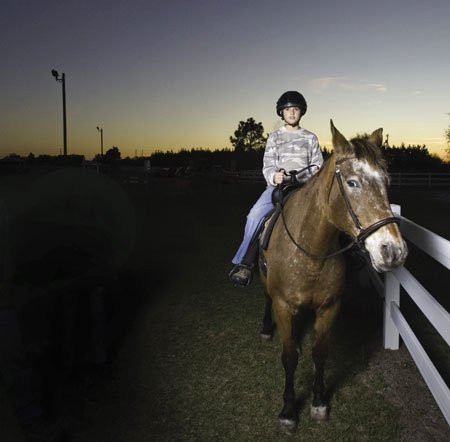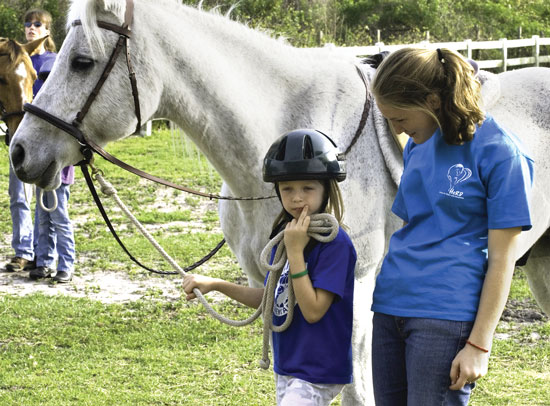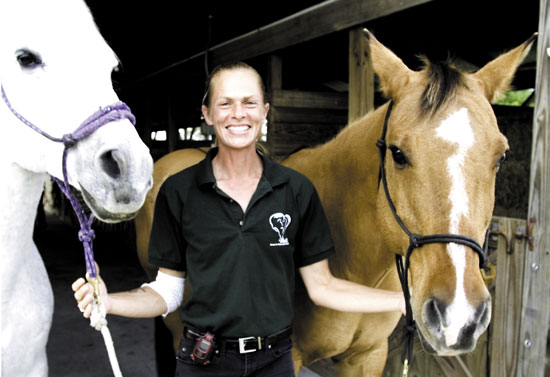What do you get when you combine good old-fashioned horse sense, the strength of horse power, and creative physical therapy techniques? The answer is Horses for Riders with Disabilities. Today, HeRD is giving hope and a better quality of life to many children and adults through equine therapy.

HeRD participant Kole Copple takes “Duke” around the ring
during a riding lesson.
Founded more than 20 years ago as a ministry for the disabled at the Woodlands Lutheran Camp in Montverde, the program has been known by several different names. Over the years, HeRD evolved into an official Special Olympics Training program and therapeutic riding program. When the camp closed in 2005, Nancy Humbyrd and Patricia Fulton were determined not to let HeRD die. They set it up as an independent non-profit corporation and moved the program to a Clermont facility.
The team of trained assistants and therapists offer hope as well as measurable physical and mental improvements for 60 students, using nine gentle horses. The new facility in west Clermont off State Road 50 features a large barn, fenced paddocks, lots of pasture, and plenty of parking. Trees shade the paddocks, and a “pretend” horse is available for newcomers before they straddle the real thing.
Adaptive riding teaches skills such as left and right sequencing, following directions, and much more. The camaraderie of the group lessons is especially enjoyable for students who have limited opportunities for social interaction.
“We take the time to really get to know our students and to find ways to address their individual needs,” explains former director Nancy Humbyrd. “When people do a lot of sitting, such as in a wheelchair, they lose their ability to balance and they lose core strength. We can retrain those muscles with both grooming the horses and riding.”

Seven-year-old rider Jessica Copple prepares for a lesson at the HeRD
facility. Riding lessons are offered year-round for adults and children at
the beginner and intermediate level.
When students sit atop a horse, they instinctively tighten their stomach muscles. A person’s body elongates and struggles to right itself, achieving balance and harmony with the horse’s movement. Therapeutic lessons address the impairments that come from cerebral palsy, strokes, traumatic brain injuries, birth defects, and other muscular and physical maladies.
Student Tamara Coleman has right-side muscular disabilities and brain-muscle connectivity challenges. She sustained a traumatic brain injury during a brutal attack in 1984.
“My muscles contract and tighten, making them unusable,” Tamara says. “When I ride, I can feel my muscles relaxing, lengthening, and I can see that happening with other students, too.”
Tamara’s been riding for 10 years and says the program “has changed my life.” She recently expanded her lesson schedule to include multiple weekly sessions and participation in the newly formed, synchronized riding team.
“Synchronized riding is very difficult,” she explains. “You have to pay attention to your own horse and also what the others are doing.”
She laughed, adding that members of the sync team now frequently boss each other around, which demonstrates their amazing new-found levels of ability.
Lynne Kugler, one of the program’s riding instructors says that students range in age from a tiny three-year-old to “mature,” but regardless of their age or ability, they learn body awareness and gain trunk strength.
HeRD strives to give students the full range of equine experience and requires them to help take care of the horses to the best of their ability. Equine-assisted activities, including riding, driving, tacking, and grooming, all have tremendous therapeutic value.
Thanks largely to their easy gait, gentle dispositions, and aesthetic beauty, the nine equine members of the HeRD program play a large role in the physical and mental therapeutic treatment of a wide variety of mental and physical disabilities. The warmth and motion of the horse work to provide natural relaxation. HeRD students also benefit from the sense of accomplishment of getting the large animals to follow their commands.
Of course, it takes more than just horses. Equipment, trained instructors and assistants, facilities, and carefully organized treatment plans help enable the students to retake control and improve their quality of life.
Certified riding instructors direct the classes of three to four riders. In addition, students work with volunteer assistants who offer extra muscle when a job requires more strength than a student possesses. The volunteers also keep easily distracted students focused and remind students with memory loss of what to do next. However, volunteers are strongly encouraged to let students do things for themselves whenever possible.
“The HeRD Program is about trust and the relationships that are formed,” says Tamara. “After my attack, my injuries were so severe that I was told I would not survive. Then I was told I would not have any kind of quality of life. Riding and a lot of good medical care have helped me prove them all wrong.”
Tamara believes that she’s able to succeed because of the trust she has in the HeRD staff.
“They believe in me so I believe in myself,” she explains. “During lessons I go through a whole range of emotions, including those that come from frustration. But I’ve learned to work through it and not give up.”

Experienced horsewoman Stacey Tumbloo has joined the team as
HeRD’s new program director.
Changes in the Saddle
HeRD names a new director.
Native Alaskan Ineqsunaq (aka Stacey) Tumbloo saddled up to begin her duties as the new program director for HeRD in February. Former director Nancy Humbyrd is riding off into retirement at her own secluded ranch in Missouri.
Stacey owned and operated Riding on Wings, an Alaskan therapeutic riding program, and also bred and raced sled dogs for nearly 20 years. She raced on the professional sled dog circuit, but had to give it up after a sustaining a serious spinal injury.
Stacey has three children, all with disabilities, and became acquainted with therapeutic riding when one of her own children participated in a similar program. That program changed her son’s life and inspired her to create her own. A horse enthusiast since age 11, she is a certified master instructor for both standard riders and for those with disabilities; she also has an extensive background in animal training.
Stacey became acquainted with Clermont’s HeRD Program after attending two certification clinics.
“I loved everything I heard about the program,” she says. “The students, the volunteers, the instructors, and the tremendous support the program has from the community!”
Readily acknowledging that she has a steep learning curve adapting to a well-established program, Stacey nevertheless has dynamic and ambitious plans for the HeRD Program.
“I plan to continue with HeRD’s mission statement, focusing on growth and expansion,” she says. “I’d like to see these wonderful services maybe available to even more people.”
Want To Know More?
HeRD
11010 Key Lime Drive
Clermont, Florida 34711
E-mail: herd@earthlink.net
Phone: (352) 429-0064
Web site: www.herdprogram.com






